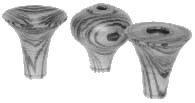 |
||||||
|
||||||
|
soprano in c - alto in f or descant in g - tenor in c or d - bass in F (can be easily underblown to C) - no great bass is needed.
Tenor and bass have an extra foreshortened fingering ("Applikatur") so that they can be played with small hands. |
|
Important:
The MILLA®-crumhorn is an invention by Stefan Beck - musikhandwerk Berlin - and is protected as a trade mark not to be copied by other instrument-makers; it is an original MILLA®-crumhorn only with the 'trade mark' of the musikhandwerk workshop. |
|
sample music: Your are listiening "L'arboscello ballo furlano" from Mainerio.
Played on MILLA®-Crumhorns by I MILLANTATORI (Joshi Obata, Wolfgang Vogel, Friedemann Schmidt, Hans-Jürgen Burggaller and Stefan Beck) Berlin . You will be hearing a change of bells in the refrain. This is an MP3-file (MPEG-1 Layer 3). You can listen with the QuickTime™-Plugin directly in your webbrowser and also with every external MP3-player. Apple and QuickTime are a registered trademarks of Apple Computer Inc. Saving and using the is allowed for private use only. Every commercial use without written permisson from bec-musikhandwerk is strictly prohibited. |


